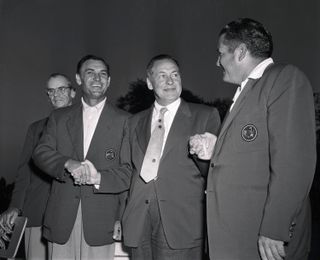Ben Hogan had not played a competitive round for 10 months prior to The Masters Tournament of 1967. He was 54, he was suffering a persistent shoulder injury, and his troublesome legs were aching. But on Saturday 8th April at Augusta National, “Bantam Ben” shot the lowest round of the tournament to give himself a realistic chance of the most unlikely victory. This is the story of how the sweet-swinging veteran equalled a Masters scoring record in his last ever Masters outing.
Hogan was a late developer as a professional. Unlike his contemporaries Sam Snead and Byron Nelson (all of whom were born in 1912), his early years in the paid ranks were tough and he didn’t get an individual win until 1940, some 10 years after turning pro. His nine Major titles all came in a relatively short spell between 1946 and 1953 with his two Masters victories were in 1951 and 1953.
In 1951 Hogan caught and passed Skee Riegel in the final round at Augusta. Riegel had been US Amateur Champion but his runner-up finish to “The Hawk” in 1951 was the highlight of his professional playing career.
1953 – A Stellar Year For the Hawk
Hogan at the 1953 Masters with Bobby Jones (centre) and Ed “Porky” Oliver (right)
(Image credit: Getty Images)
In 1953, Hogan enjoyed a stellar year. Aged 40, he won three Majors and only logistics meant he couldn’t go for the Grand Slam. Later in the year he won the US Open and then The Open Championship at Carnoustie, in his only start in the event. That trip across the pond prohibited him from competing in the PGA Championship and the chance to make more history by claiming all four majors in a calendar year. That could have been possible because, in April, he had stormed to a second Masters title. He smashed the scoring record, finishing on 14-under-par, four clear of Ed “Porky” Oliver – a pro who was renowned for second place finishes in major championships, (although that was a slightly exaggerated reputation, as he had just three of them.)
Hogan’s competitive schedule by the late 1960s was limited to say the least. He hadn’t won on the PGA Tour since 1959 and, by the time of the ’67 Masters, he hadn’t played a tournament since the US Open at the Olympic Club the previous June, (an event in which he finished a creditable 12th.) In discussions with reporters early in Masters week, he reckoned he’d played just 15 rounds of golf in total that year.
It didn’t seem to have too much effect on his legendary tee to green game. Even…
..
Click Here to Read the Full Original Article at Golf Monthly…
